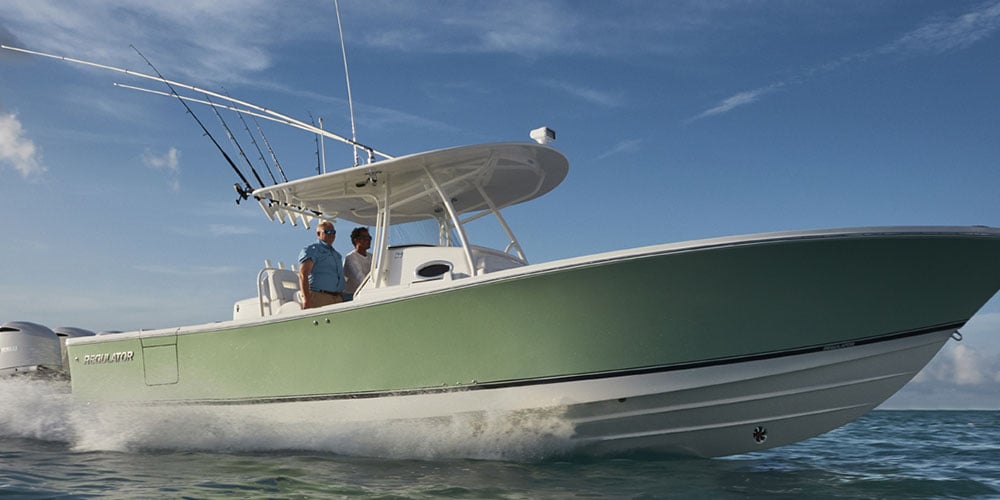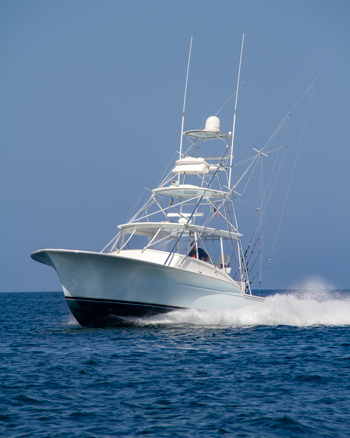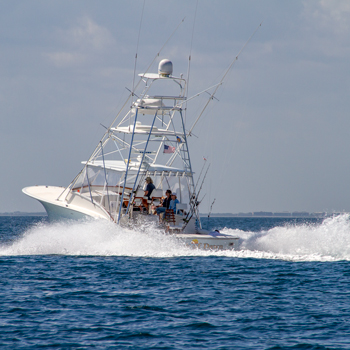
An outrigger is designed to hold line from your rod using tension release clips that put the fight back in your hands when something bites. Because outriggers are hands-free until a fish strikes, one boat can sport multiple outrigger-supported poles at different angles to lure many fish over a greater area. We'll walk you through what you need to know and help you find the right ones for your boat.
What Outriggers Do

Outriggers are long poles deployed from the sides of fishing boats to widen the trolling area and accommodate multiple lines. Outriggers are used when trolling for surface fish.
How Outriggers Work
Outriggers are common on offshore and Great Lakes sportfishing boats. They consist of rigid or telescopic poles between 15 and 35 feet in length that are swung outboard at a wide angle. Outriggers allow trolling of up to two lines per pole (a.k.a. stacking) and position bait or lures outside the wake or prop wash for more life-like action. The fishing line, which is paid out from a rod, is attached to tag lines via tensioned release clips at one or more points on the outrigger pole. As soon as a fish strikes the bait or lure, the clip releases the line, which swings directly behind the boat. Now the angler can play and land the fish with rod and reel.
What to Look for when Selecting Outriggers

An outrigger kit, like this Grand Slam 380 from Taco Marine, includes everything you need including telescoping outrigger poles, outrigger mounts and line caddies.
- Telescoping vs. fixed length: Telescopic poles are practical because they store easily when not in use and can be retracted to pass under low bridges. We like stainless steel spring-loaded snap buttons for locking the sections when extended. Rigid one-piece or sectional models with bolted extrusions provide more strength and are better suited for heavy-duty offshore fishing.
- Aluminum vs. fiberglass/carbon fiber: Cold-drawn aluminum and duplex anodized poles are strong and look great, while fiberglass is lighter, more economically priced and impervious to corrosion. We recommend light outriggers for small and narrow boats because they have less tendency to upset weight balance, which is an important safety consideration for trolling perpendicular to waves and swells.
- Spreaders or no spreaders: Spreaders are used to increase stiffness and rigidity of the poles. They are perpendicular bars that keep taut guy wires apart along the pole in order to prevent it from bending and breaking under load. Spreaders also create more space between stacked lines.
- Mounting options: Outriggers can be mounted on the side or top of a cabin, on radar or fishing arches or on the gunwale. On simple mounts, pulling a pin will drop the outrigger pole from vertical to the trolling position. Adjustable T-top mounts like the Sidewinder angle the outrigger outboards for trolling by turning a handle on the inside of the cabin ceiling. For storage and running, the pole swings into a straight-back position. Some mounts offer incremental adjustments to the vertical angle and a lay-down feature, which places the pole down horizontally in a straight-back position to pass under low bridges. We recommend backing outrigger mounts with heavy gauge aluminum plates if you fish heavy tackle and rough water.
- Rigging Kits: Outrigger rigging kits include all the necessary components to rig outrigger poles. Typical components include glass rings (or pulleys), outrigger cord, release clips, snap swivels, crimps and other components.

Conclusion
Outriggers are practical accessories for near- or offshore trolling. They help cover a larger fishing area with more lines and they improve the chances of making a catch. The poles are attached to the boat’s deck, cabin or gunwale with mounts that accommodate a variety of preferences and boat designs. Fixed poles require adjustable mounts for swinging them outboard into trolling position and bringing them into a straight-back and horizontal position inboard for storage and running. Longer poles cover more area but are more cumbersome to handle and store. They also can be disruptive to the weight balance of small boats and narrow skiffs. We recommend telescoping poles as a versatile alternative because they can be retracted for passing under bridges and stow more easily. Fiberglass poles have less rigidity than aluminum but are lighter, which makes them more suitable for small boats, and they fit tighter budgets.
Related: Deep Sea Fishing Gear Guide